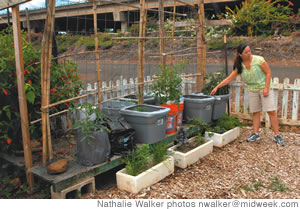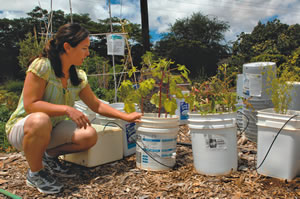Garden In a Box
More and more folks are growing their own produce, even condo-dwellers. Here’s a primer for getting started. It’s bursting out all over the place. It’s on walls, hanging from bags and creeping out from an assortment of funky containers

By .(JavaScript must be enabled to view this email address)
E-mail this story | Print this page | Archive | RSS

|
It’s bursting out all over the place. It’s on walls, hanging from bags and creeping out from an assortment of funky containers. I’m talking about the results of personal gardening, and everybody seems to be doing it.
The new “green” fad actually involves plants. There’s vertical gardening where you have a whole wall with plants sprouting out of it, and community gardening of the square foot variety (each square foot or two has a plant). There are green tentacles of herb and foliage springing out of bags hanging from restaurant walls, and a number of specialty bags for growing strawberries and tomatoes being sold in stores. Then there’s the more traditional lanai garden, but even that’s been modernized with green conscious folks claiming all kinds of “found” goods as potting containers.
The container gardening fad isn’t only for green thumbs. Armed with a little knowledge, some patience and perseverance, and a few tips from Pearl City Urban Garden Center’s (PCUGC) helpful experts, a private space of verdant bounty is possible even for newbies, and even in a small apartment.
You’ll need containers, dirt, seeds, a watering can and a bit of elbow grease.
Some people have a knack for sprouting and nurturing all things green. For the rest of us, there are the PCUGC experts - trained in a hands-on master gardener program, an extension of UH Manoa’s College of Tropical Agriculture - who are a phone call away, ready to answer your questions and direct you to a wealth of websites and resources. They’ve already done all the trial-and-error work and they’re happy to share the tricks of the trade, free of charge.
Tips for getting started:
Container: “I recommend going to your local garden center to see what types of containers are available,” says Jayme Grzebik, urban horticulturist and UH extension agent. “It’s important to have a lightweight container. There are Styrofoam ones that are aesthetically nice, or even plastic is fine, but it won’t last as long in our heat and sun.”
Grzebik, who conducts the master gardener program, recommends that the container have a 24- to 32-inch length so that it can hold at least three kinds of plants. The container also needs several drainage holes.

|
The Urban Garden Center’s 30 acres feature a number of creative planter containers made from recycled material: 5-gallon buckets, large Styrofoam packaging leftovers, structures made from wooden planks. “Our volunteer gardeners like to think outside the box,” Grzebik laughs.
Soil: The trick is really in the soil.
“If you’re starting well you’re going to have less insect problems, fewer disease problems, and your plants will be healthy and thriving - full of veggies just like you want them to be,” says Grzebik.
She recommends a bag labeled “potting media,” because it holds moisture, drains well and keeps cool. Grzebik warns against cheaper soils, like one labeled “compost,” which will rob the plants of nitrogen. Another counterintuitive no-no is digging the dirt out of your backyard. “Our soil is eroded,” she says. “We’re down to a high iron content; we have very acidic soils.” Because of this, even many home gardeners plant in large containers or raised beds.
Plants: Grzebik suggests coupling vegetables with herbs: “You’re not only attracting pollinators but you’re attracting beneficial insects.” Good insects, like ladybugs (there are 12 species in Hawaii), keep away bugs that’ll eat your plants or cause diseases. Herbs like cilantro, basil, mint, dill or fennel “really attract those beneficial insects so you can create a balance within that little environment.
“Tomatoes are popular and the easiest kind is the bush variety or vine-ripe, which can be trellised in a pot - avoid the more difficult beefsteak or heir-loom. Other easy options are eggplant, green onions, pineapple (“it’s ornamental”) and cucumbers and squash (“it’ll spill out onto your deck”).
You can grow your own organic veggie medley or gourmet salad right on your lanai. Buying already germinated plants offers a head start, but with lettuce, which is one of the least fussy plants, just throw the seeds right into the soil. Leafy greens come in abundant variety and grow best in the cooler, shorter day-length of Hawaii’s winter,
Page 1 of 2 pages for this story 1 2 >
E-mail this story | Print this page | Comments (0) | Archive | RSS
Most Recent Comment(s):








